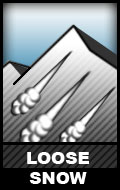Weekend Avalanche Outlook
Issued Saturday, April 8, 2017 at 12:30am. This is a general backcountry (recreational) avalanche advisory for Chugach State Park with the Front Range and South Fork Eagle River areas as the core advisory zones.
Early in the day:
Later in the day:
Avalanche danger will rise throughout the day with increasing temperatures and solar radiation. Be mindful of the sun and temperature’s effect on the snow. Signs of increasing danger include wet loose avalanches from steep solar aspects, rollerballs, and increasing snow penetration at your feet. Even where these danger signs do not give warning, beware that the sun and warm temperatures can destabilize the snowpack and reawaken persistent slab instabilities.
Make sure you know how to identify avalanche terrain and dangerous avalanche paths that can threaten commonly traveled routes like summer trails (e.g. Crow Pass, Penguin Ridge, Falls Creek, Powerline, Flattop, O’Malley Gully). Warm temperatures may trigger natural avalanches in the upper elevations that can run into the lower elevations and cross terrain and trails that may be flat and snow free (e.g. Falls Creek).
Practice safe travel protocols, carry necessary personal safety and rescue gear, and leave a trip plan (with emergency response) with someone that is staying in town.
Avalanche Problems:
Persistent slabs up to D3 in size are possible on steep (35*+) terrain above 3000′ on multiple aspects. The persistent slab problem is expected to be the most worrisome on solar aspects (S to W) later in the day, as warming temperatures and solar radiation have the potential to awaken persistent instabilities at the middle and bottom of the snowpack. On shady (northerly) aspects, persistent slabs are expected to be the most problematic at the upper elevations especially in areas with convex terrain features, where there are fatter pockets of wind loaded snow, and areas where the snowpack is thinner and persistent weak layers may be more readily impacted by a human trigger.
Snowfall and windloading the past couple weeks has created a slab on top of a weak, heavily faceted layer that developed during the month long dry spell. This faceted layer generally overlies a hard wind slab. There is also the potential for lingering pockets of old buried surface hoar, which have been stressed by recent loading and warm temperatures. Additionally, a pronounced layer of very weak and uncohesive basal facets and depth hoar is widespread throughout Chugach State Park.
Persistent slabs are likely to behave unpredictably with hard slab characteristics, and could let a human trigger get well on to the slab before releasing above and around – making escape difficult.
Wind slabs up to D2 in size are possible on terrain steeper than 35* above 3000′. These wind slabs are expected to be the most problematic on leeward (primarily west to north aspect) upper elevation terrain, especially along ridges and cross-loaded features like gully sidewalls.
Natural wet loose avalanches are likely this weekend in the afternoons on steep, solar aspects. These wet loose avalanches are likely to be relatively slow moving, but will be heavy and could carry a lot of volume. They will have the potential to injure a person due to their wet-concrete-like nature, and could definitely push someone over dangerous terrain and even bury a person in a terrain trap. Be on the lookout for paths that could channel naturally triggered wet loose avalanches; don’t linger around such paths. Natural wet loose activity and rollerballs are a red flag of increasing danger due to warming and radiation. Also, if traveling around steep rocky terrain on solar aspects (especially if channeled), watch for rockfall triggered by the sun thawing snow and ice.
Human triggered dry loose avalanches are likely on steep northerly terrain, and could also be triggered in the upper elevations on other aspects where there’s drier snow. These will likely be faster moving, but lower volume, than a wet loose. These could prove problematic given terrain traps and exposure. While they may not typically involve enough mass to bury a person, they could definitely cause a fall or loss of control.
A significant amount of new snow and strong wind (predominantly SE) this week has grown cornices and made them more susceptible to falling. Cornices have grown primarily over leeward west to north aspects and cross loaded terrain features like gully sidewalls. Warm temperatures and solar radiation will weaken cornices, and make them more prone to falling; cornices may fail naturally later in the day.
As always, don’t approach a snowy ridge to look down slope unless you’re sure it’s not corniced. Remember that cornice falls pose an inherent hazard, as well as their ability to trigger an avalanche as they “bomb” the slope they fall onto. Give corniced ridges a wide berth; they can break back further than expected.
Mountain Weather:
Partly cloudy skies with light SE wind and alpine temps from the mid 30s to mid 20s.
__________
Many avalanche accidents that have happened in Anchorage’s backyard of Chugach State Park could have been prevented by basic avalanche awareness. This level of awareness can typically be gained through a free or low-cost class. Unfortunately, such opportunities are few and far between in the spring. If you missed the many offerings earlier this season, make sure you take advantage of the numerous free and low-cost courses that will be offered in the fall. You can start learning with some free online resources here. Getting avalanche education is a big part of recreating safely on your vast and wondrous public land in Alaska, and being able to enjoy the mountains during the snow season will greatly enhance your life.
Here are links to further information on fatal avalanche accidents in Chugach State Park. You can learn from others’ mishaps.
__________
*click avalanche problem icons and hyperlinks for further info





